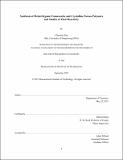| dc.contributor.advisor | Dincă, Mircea | |
| dc.contributor.author | Sun, Chenyue | |
| dc.date.accessioned | 2022-07-27T18:22:09Z | |
| dc.date.available | 2022-07-27T18:22:09Z | |
| dc.date.issued | 2021-09 | |
| dc.date.submitted | 2022-07-27T11:43:34.693Z | |
| dc.identifier.uri | https://hdl.handle.net/1721.1/144097 | |
| dc.description.abstract | Porous crystalline solids such as metal-organic frameworks (MOFs) and crystalline porous polymers are unparalleled platforms for studying fundamental processes involving gaseous components, which ultimately leads to applications such as catalysis, gas sorption and gas separation. To that end, new materials, and new synthetic methods are constantly needed to fuel the growth of our knowledge. The aim of this thesis is to provide new avenues to constructing crystalline frameworks in a designed, target-driven manner. Applications of the newly synthesized materials are also detailed to demonstrate their unique advantages and showcase their versatility.
Chapter 1 provides a summary of the current landscape of gas-solid reactions in MOFs with an emphasis on introducing MOFs to chemists from a homogeneous catalysis background. Both important concepts and practical examples are presented to compare and contrast chemistry in solution and chemistry inside MOFs. Opportunities and challenges are identified for future development of the field and deeper realization of MOFs’ potential. Chapter 2 introduces a new strategy, i.e. in-situ metalation, for incorporating flexible ligands into the backbone of MOFs and showcases this method with the synthesis of a new MOF, ZrTpmC*, which acts as a site-isolated and well-defined trispyrazolylmethane ligand in the solid state. In Chapter 3, the merit of site isolation in ZrTpmC* was demonstrated through study of Cu(I)-mediated NO reductive coupling, a reaction of importance to biological systems and automobile emission abatement. A previously hypothesized but unseen N₂O₂•– intermediate was fully characterized by a range of spectroscopic techniques. In Chapter 4, photochemical topochemical dimerization reaction is introduced as a new strategy for synthesis of porous crystalline polymers. To exemplify, topochemical polymerization of the tetrahedral monomer MTBA is described and the adsorption property, solution processibility and recyclability of polyMTBA is discussed. | |
| dc.publisher | Massachusetts Institute of Technology | |
| dc.rights | In Copyright - Educational Use Permitted | |
| dc.rights | Copyright MIT | |
| dc.rights.uri | http://rightsstatements.org/page/InC-EDU/1.0/ | |
| dc.title | Synthesis of Metal-Organic Frameworks and Crystalline Porous Polymers and Studies of Their Reactivity | |
| dc.type | Thesis | |
| dc.description.degree | Ph.D. | |
| dc.contributor.department | Massachusetts Institute of Technology. Department of Chemistry | |
| dc.identifier.orcid | https://orcid.org/0000-0002-7524-5323 | |
| mit.thesis.degree | Doctoral | |
| thesis.degree.name | Doctor of Philosophy | |
